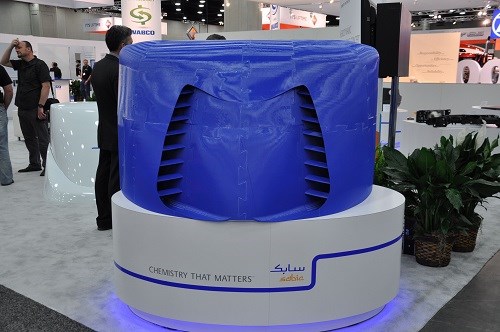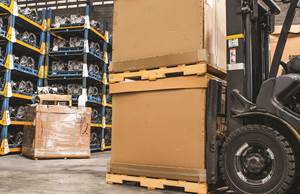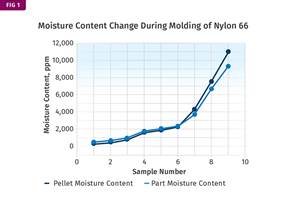Progress Continues on Novel Truck Fairing Concept Design
SABIC's newest thermoplastic truck fairing design concept set to outperform earlier commercial designs.

Tightening fuel efficiency standards for larger trucks both in the U.S. and elsewhere, along with seeking a more environmentally responsible alternative to thermosets without sacrificing performance, has further prompted SABIC Innovative Plastics, Pittsfield, Mass., to come up with a novel thermoplastic roof fairing design concept that can potentially reduce fuel consumption of a heavy-duty truck by at least 3%.
Additionally, automotive general manager Scott Fallon says that the new design concept is aerodynamically optimized to deflect air by accelerating airflow through and across the top and sides of the roof fairing. This lead up to 5.9% drop in drag, which significantly improves the aerodynamic performance and fuel efficiency of the truck.
The new design concept incorporates air ducts to reduce front-end pressure and accelerate airflow both over the surface and through the fairing itself. In contrast, conventional roof fairings achieve aerodynamic efficiencies simply by maximizing airflow over smooth, closed surfaces. Fallon believes that through the improved aerodynamic performance of this one application alone, fleet operators stand to save millions of dollars in fuel costs each year and over the lifetime of the entire vehicle fleet.
A large, blue 3D printed version of the company’s aerodynamically-optimized roof fairing was displayed at the Mid-America Trucking Show in Louisville, Kentucky this past March. The timing is crucial as the more stringent fuel efficiency and greenhouse gas emission standards for medium- and heavy-duty trucks beyond model year 2018 are expected to be in place by March 2016.
Just three years ago, the company played a key role in the development of the industry’s first injection-molded thermoplastic roof fairing, which is installed on heavy-duty trucks on the road today. SABIC worked with provider of engineered plastic systems CK Technologies, Montpelier, Ohio, and Volvo Trucks North America. This large component, molded with SABIC’s tough Cycoloy PC/ABS resin and CK Technologies’ proprietary in-mold coating technology, weighs 20-30% less than a comparable thermoset (e.g. SMC).
SABIC recognizes that a range of strategies are needed to meet new tougher efficiency targets. Says, Fallon, “Our lightweight materials can help reduce the overall weight of a truck, but those savings can be easily offset by increased payload capacity so we are finding other ways to help the industry realize fuel economy improvements. This is where thermoplastic-based solutions can be game-changing, thanks to the design freedom they deliver to create unique and intricate aerodynamic surfaces and structures like those found on our roof fairing concept.”
The company used Computational Fluid Dynamics (CFD) simulation technology to evaluate and quantify the aerodynamic performance of its roof fairing concept. Specifically, CFD modeling was applied to compare a baseline day cab with dimensions and geometry representative of top aerodynamically-optimized roof fairing. The CFD data helped reveal opportunities to alter the design for improved airflow and reduced drag.
In a recent update, SABIC sources confirm that further collaboration with the industry on the performance and styling requirements of truck OEMs has led them to pursue additional enhancements to the roof fairing design concept. This includes material selection—with Cycoloy PC/ABS and Noryl GTX PPO included in the running, as well as processing and tooling options.
A preliminary 1;8 scale wind tunnel test has already taken place, with a 30% model scale test scheduled within this year. On-road testing with the EPA—in support of its rule-making initiative for Phase 2 Greenhouse Gas Emissions and Fuel Efficiency Standards for Medium- and Heavy-Duty Vehicles, will take place before year’s end at the Southwest Research Institute in San Antonio, Texas.
Want to find or compare materials data for different resins, grades, or suppliers? Check out Plastics Technology’s Plaspec Global materials database.
Related Content
Scaling Up Sustainable Solutions for Fiber Reinforced Composite Materials
Oak Ridge National Laboratory's Sustainable Manufacturing Technologies Group helps industrial partners tackle the sustainability challenges presented by fiber-reinforced composite materials.
Read MoreThe Fantasy and Reality of Raw Material Shelf Life: Part 1
Is a two-year-old hygroscopic resin kept in its original packaging still useful? Let’s try to answer that question and clear up some misconceptions.
Read MoreWhat's the Allowable Moisture Content in Nylons? It Depends: Part 2
Operating within guidelines from material suppliers can produce levels of polymer degradation. Get around it with better control over either the temperature of the melt or the barrel residence time.
Read MoreTracing the History of Polymeric Materials: Aliphatic Polyketone
Aliphatic polyketone is a material that gets little attention but is similar in chemistry to nylons, polyesters and acetals.
Read MoreRead Next
People 4.0 – How to Get Buy-In from Your Staff for Industry 4.0 Systems
Implementing a production monitoring system as the foundation of a ‘smart factory’ is about integrating people with new technology as much as it is about integrating machines and computers. Here are tips from a company that has gone through the process.
Read MoreTroubleshooting Screw and Barrel Wear in Extrusion
Extruder screws and barrels will wear over time. If you are seeing a reduction in specific rate and higher discharge temperatures, wear is the likely culprit.
Read MoreHow Polymer Melts in Single-Screw Extruders
Understanding how polymer melts in a single-screw extruder could help you optimize your screw design to eliminate defect-causing solid polymer fragments.
Read More
















.png;maxWidth=300;quality=90)









